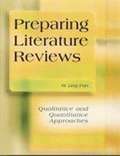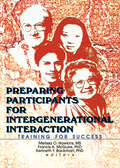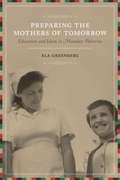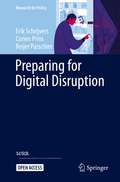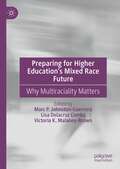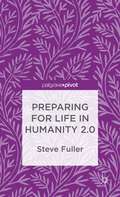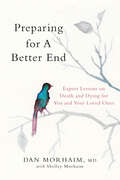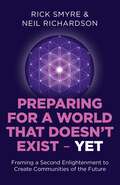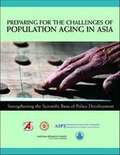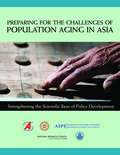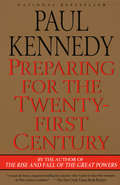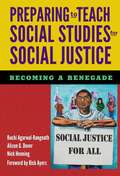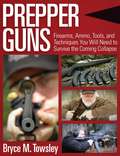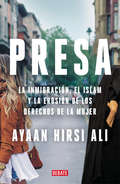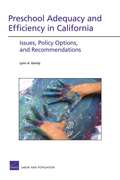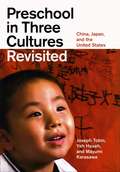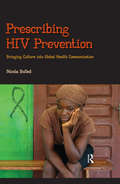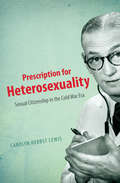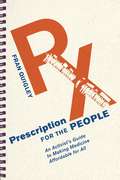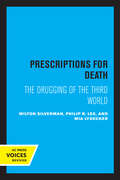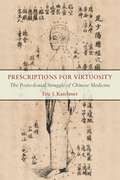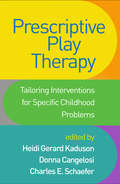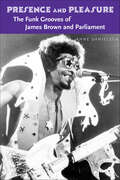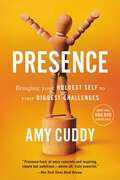- Table View
- List View
Preparing Literature Reviews: Qualitative and Quantitative Approaches
by M. Ling PanHow to review and synthesize research reports for academic writing such as a thesis or dissertation.
Preparing Literature Reviews: Qualitative and Quantitative Approaches, 4th Edition
by M. Ling PanA literature review is an original work based on a critical examination of the literature on a topic. The reviewer should evaluate the available evidence as well as relevant theories (while noting gaps in the literature) and create a synthesis that provides a comprehensive overview of the literature.
Preparing Participants for Intergenerational Interaction: Training for Success
by Kenneth Backman Melissa Hawkins Francis A McguirePreparing Participants for Intergenerational Interaction: Training for Success examines established intergenerational programs and provides the training methods necessary for activity directors or practitioners to start a similar program. This book contains exercises that will help you train colleagues and volunteers for these specific programs and includes criteria for activity evaluations. Preparing Participants for Intergenerational Interaction will help you implement programs that enable older adults to build friendships, pass down their skills and knowledge to adolescents, and provide youths with positive role models.Discussing the factors that often limit the interaction of older adults with youths, this text stresses the importance of conveying information and history to younger generations. You will learn why the exchange between different generations is crucial to society and to the improvement of the community in which you live. Preparing Participants for Intergenerational Interaction provides you with proven suggestions and methods that will make your program successful, including: examining Howe-To Industries, a program that teaches entrepreneurial skills to youths through older adults focusing on activities between older adults and youths that address aging sensitivity and racial and ethnic understanding defining the roles of a mentor, including teacher, trainer, developer of talent, and counselor increasing support and understanding in your community by defining target markets and selling the project to the public describing the aspects of group dynamics and how group decisionmaking methods are used to assess the success of the program and its volunteers understanding the community where participants live in order to address issues important to them, such as poverty and other social problems Containing sample handouts, self-evaluations, and detailed lessons for different types of programs, this book offers you guidelines that apply to participants that have a variety of needs within different communities. Preparing Participants for Intergenerational Interaction: Training for Success will enable you to help older adults remain an active and essential part of these communities by teaching youths valuable life skills they may not receive from anyone else.
Preparing The Mothers of Tomorrow
by Ela GreenbergFrom the late nineteenth century onward, men and women throughout the Middle East discussed, debated, and negotiated the roles of young girls and women in producing modern nations. In Palestine, girls' education was pivotal to discussions about motherhood. Their education was seen as having the potential to transform the family so that it could meet both modern and nationalist expectations. Ela Greenberg offers the first study to examine the education of Muslim girls in Palestine from the end of the Ottoman administration through the British colonial rule. Relying upon extensive archival sources, official reports, the Palestinian Arabic press, and interviews, she describes the changes that took place in girls' education during this time. Greenberg describes how local Muslims, often portrayed as indifferent to girls' education, actually responded to the inadequacies of existing government education by sending their daughters to missionary schools despite religious tensions, or by creating their own private nationalist institutions. Greenberg shows that members of all socioeconomic classes understood the triad of girls' education, modernity, and the nationalist struggle, as educated girls would become the "mothers of tomorrow" who would raise nationalist and modern children. While this was the aim of the various schools in Palestine, not all educated Muslim girls followed this path, as some used their education, even if it was elementary at best, to become teachers, nurses, and activists in women's organizations.
Preparing for Digital Disruption (Research for Policy)
by Erik Schrijvers Corien Prins Reijer PasschierThis open access book offers an analysis of why preparations for digital disruption should become a stated goal of security policy and policies that aim to safeguard the continuity of critical infrastructure. The increasing use of digital technology implies new and significant vulnerabilities for our society. However, it is striking that almost all cyber-security measures taken by governments, international bodies and other major players are aimed at preventing incidents. But there is no such thing as total digital security. Whether inside or outside the digital domain, incidents can and will occur and may lead to disruption. While a raft of provisions, crisis contingency plans and legal regulations are in place to deal with the possibility of incidents in the ‘real world’, no equivalence exists for the digital domain and digital disruption. Hence, this book uniquely discusses several specific policy measures government and businesses should take in order to be better prepared to deal with a digital disruption and prevent further escalation.
Preparing for Higher Education’s Mixed Race Future: Why Multiraciality Matters
by Marc P. Johnston-Guerrero Lisa Delacruz Combs Victoria K. Malaney-BrownIncreasing attention and representation of multiraciality in both the scholarly literature and popular culture warrants further nuancing of what is understood about multiracial people, particularly in the changing contexts of higher education. This book offers a way of Preparing Higher Education for its Mixed Race Future by examining Why Multiraciality Matters. In preparation, the book highlights recent contributions in scholarship – both empirical studies and scholarly syntheses – on multiracial students, staff, and faculty/scholars across three separate yet interrelated parts, which will help spur the continued evolution of multiraciality into the future.
Preparing for Life in Humanity 2.0
by Steve FullerDeveloping directly from Fuller's recent book Humanity 2. 0, this is the first book to seriously consider what a 'post-' or 'trans'-' human state of being might mean for who we think we are, how we live, what we believe and what we aim to be.
Preparing for a Better End: Expert Lessons on Death and Dying for You and Your Loved Ones
by Dan MorhaimA vital roadmap to planning your own end-of-life care.While modern Americans strive to control nearly every aspect of their lives, many of us abandon control of life's final passage. But the realities of twenty-first-century medicine will allow most of us to have a say in how, when, and where we die, so we need to make decisions surrounding death, too. Or those decisions may be made for us. Threading compelling real-life stories and practical guidance throughout, this book helps readers navigate end-of-life care for themselves and their loved ones.In this practical guidebook, Dr. Dan Morhaim and Shelley Morhaim offer readers hope, empowerment, and inspiration. What we choose for our end-of-life care, they assert, depends on accurate information and on our personal values. We need these not only to understand new medical advances but also to appreciate the wisdom of humanity's past and present. Dan Morhaim, an emergency medicine physician and former Maryland state legislator, guides readers through the medical, legal, and financial maze of end-of-life care. He details the care choices available to patients and explains why living wills and advance directives are a necessity for every American. He tells readers where to find free and readily available living wills and advance directives and why it is so important for everyone—young and old—to complete them. Meanwhile, Shelley Morhaim draws on her experience as a therapeutic music practitioner for hospice and hospital patients to offer compassion to readers facing hard decisions.The authors reflect on a number of timely topics, including• what doctors—including Dr. Morhaim specifically—want for themselves in terms of end-of-life care• how legislative initiatives on assisted dying vary by state• how to obtain medical orders for life-sustaining treatment (MOLST/POLST)• how to deal with dementia• what to expect from palliative and hospice care• how to cope with pain at the end of life, including with medical cannabis and narcotics• how organ donation and body disposition work• how to communicate individual needs to lawyers, physicians, and family members• how to make decisions when selecting the best care for yourself and othersand more.Organized as a roadmap that people should follow when they plan end-of-life care and contingencies, this book helps readers keep decisions in their own hands and spare their families the uncertainty and trauma of guessing about their end-of-life wishes. Breaking down the barriers to a difficult but essential topic, Preparing for a Better End helps readers open this often-avoided discussion with their loved ones while providing the information and guidance needed to ensure that deeply held values are reflected and honored.Praise for the Author "In The Better End, Dr. Morhaim helps the reader to see that while death does have its sting, it need not be bitter, and each of us can prepare for the end in better ways."—Maya Angelou "Dan Morhaim's message is a must read for anyone who is facing end-of-life crisis issues and concerns, whether it be for themselves or for a family member or loved one. When so many others shun away from the topic, Dan Morhaim addresses the situation with clarity, insight, and sensitivity."—Montel Williams
Preparing for a World that Doesn't Exist - Yet: Framing a Second Enlightenment to Create Communities of the Future
by Neil Richardson Rick SmyreAre you really ready for change? Are you prepared for a world changing as fast as you can read this sentence? Most leaders say they are prepared for the future, yet many organizations and communities are doing things in the same old way they&’ve been working for decades. We&’re living on the precipice of a new era in human history. Preparing For A World That Doesn&’t Exist - Yet offers an approach to getting ready for an emerging society that will be increasingly fast paced, interconnected, interdependent, and complex. In Preparing For A World That Doesn&’t Exist - Yet, you will learn about an emerging Second Enlightenment and the capacities you&’ll need to achieve success in this new, fast-evolving world. Higher education, health and wellness, governance and the economy are transforming in ways few of us could have imagined ten or even five years ago. In this book, you&’ll get the skills you need to ride the wave of the future and the perspective you&’ll need to be ready to catch the next wave, too. Planners, physicians, government and higher-education leaders are using the principles and capacities described in this book to create better organizations, and best of all communities of the future that will lead to a planet that can thrive. Join them in looking at the future with excitement and anticipation.
Preparing for the Challenges of Population Aging in Asia: Strengthening the Scientific Basis of Policy Development
by Chinese Academy of Social Sciences"Preparing for the Challenges of Population Aging in Asia" discusses the challenges posed by a rapidly aging population and identifies needed research to help policymakers better respond to them. While the percentage of elderly people in nearly every nation is growing, this aging trend is particularly stark in parts of Asia. Projections indicate that the portion of the population age 65 and older will more than triple in China, India, and Indonesia and more than double in Japan between 2000 and 2050, based on data from the United Nations. Moreover, this demographic shift is coinciding with dramatic economic and social changes in Asia, including changing family structures and large-scale migrations from rural to urban areas. These trends raise critical questions about how nations can develop policies that best support health and economic well-being in large and growing populations at older ages. Governments in Asia still have time to determine the best ways to respond to the unfolding demographic transformation, but taking advantage of this window of opportunity will require new research to shed light on the status and needs of the aging population. Currently the research base on aging in this region is relatively underdeveloped. This book identifies several key topics for research to inform public policy, including changing roles in the family; labor force participation, income, and savings; and health and well-being of the public.
Preparing for the Challenges of Population Aging in Asia: Strengthening the Scientific Basis of Policy Development
by National Research Council of the National AcademiesPreparing for the Challenges of Population Aging in Asia discusses the challenges posed by a rapidly aging population and identifies needed research to help policymakers better respond to them. While the percentage of elderly people in nearly every nation is growing, this aging trend is particularly stark in parts of Asia. Projections indicate that the portion of the population age 65 and older will more than triple in China, India, and Indonesia and more than double in Japan between 2000 and 2050, based on data from the United Nations. Moreover, this demographic shift is coinciding with dramatic economic and social changes in Asia, including changing family structures and large-scale migrations from rural to urban areas. These trends raise critical questions about how nations can develop policies that best support health and economic well-being in large and growing populations at older ages. Governments in Asia still have time to determine the best ways to respond to the unfolding demographic transformation, but taking advantage of this window of opportunity will require new research to shed light on the status and needs of the aging population. Currently the research base on aging in this region is relatively underdeveloped. This book identifies several key topics for research to inform public policy, including changing roles in the family; labor force participation, income, and savings; and health and well-being of the public.
Preparing for the Twenty-First Century
by Paul KennedyKennedy's groundbreaking book The Rise and Fall of the Great Powers helped to reorder the current priorities of the United States. Now, he synthesizes extensive research on fields ranging from demography to robotics to draw a detailed, persuasive, and often sobering map of the very near future--a bold work that bridges the gap between history, prophecy, and policy.From the Trade Paperback edition.
Preparing to Teach Social Studies for Social Justice
by Ruchi Agarwal-Rangnath Alison G. Dover Nick HenningThis practical book shows how veteran, justice oriented social studies teachers are responding to the Common Core State Standards, focusing on how they build curriculum, support students’ literacy skills, and prepare students to think and act critically within and beyond the classroom. In order to provide direct classroom-to classroom insights, the authors draw on letters written by veteran teachers addressed to new teachers entering the field. <P><P> The first section of the book introduces the three approaches teachers can take for teaching for social justice within the constraints of the Common Core State Standards (embracing, reframing, or resisting the standards). The second section analyzes specific approaches to teaching the Common Core, using teacher narratives to illustrate key processes. The final section demonstrates how teachers develop, support, and sustain their identities as justice-oriented educators in standards-driven classrooms. Each chapter includes exemplary lesson plans drawn from diverse grades and classrooms, and offers concrete recommendations to guide practice.
Prepper Guns: Firearms, Ammo, Tools, and Techniques You Will Need to Survive the Coming Collapse
by Bryce M. TowsleyFood, water, and shelter are very important to survival. But you must also be ready to protect what is yours, because if somebody stronger, better prepared, and better equipped takes it all away, you will die. Your family will die. The only way to protect them is with firearms.Written with the law-abiding civilian in mind, Prepper Guns covers the firearms and tools needed to survive, not only for defense, but also for foraging. It is a comprehensive look at the realities of the firearms a prepper should have. Written by Bryce M. Towsley, a firearms expert and a full-time gun writer with thirty years of experience, it steps away from the "conventional wisdom” that is often spouted by prepper publishing and takes a hard, honest, look at the reality of the firearms, ammo, tools and training needed to survive at home and on the road.Prepper Guns takes a careful look at each category of firearms, ammo, sights, and accessories. Other topics include gun care and maintenance, as well as some simple gunsmithing and reloading to keep firearms repaired and ammo on hand. Finally, Prepper Guns has training suggestions and drills, plus a look at the psychology of survival, using the expertise of some of the top people in the world in these fields.If you are worried that bad things are coming and are trying to prepare, this book is the most important piece of gear you can buy. Because if you can’t protect your family, your food and your home, nothing else really matters.
Presa: La inmigración, el islam y la erosión de los derechos de la mujer
by Ayaan Hirsi AliUna relevante y enardecedora novedad para el debate actual sobre migración. «Este libro trata de la inmigración masiva, la violencia sexual y los derechos de las mujeres en Europa. Trata de un fracaso colosal por parte de la clase dirigente europea. Y trata de las soluciones al problema, de las falsas y de las reales. En los últimos años, el debate en torno a la inmigración, la integración y el islam en Europa se ha intensificado en respuesta a los atentados terroristas, a la prédica de un islam radical en algunas mezquitas y centros de culto, al resurgimiento de partidos populistas y de extrema derecha, y a la reciente llegada de una gran cantidad de inmigrantes procedentes de Oriente Próximo, África y Asia meridional, en particular (pero no solo) en 2015 y 2016. Si bien el flujo de inmigrantes ha disminuido en los últimos dos años, hay todavía muchos que intentan cruzar el Mediterráneo o alcanzar Europa por otras vías. Una consecuencia de todo ello es el cambio en la situación de la mujer que se ha producido en Europa. Ese cambio es el tema de este libro.» Ayaan Hirsi Ali La crítica ha dicho...«Ayaan Hirsi Ali es una de las figuras políticas más controvertidas de Europa, y objetivo de terroristas. Una voz suave pero apasionada.»The Boston Globe «Una figura valiente, elegante y honesta. Una mente abierta liberada de los viejos marcos de la derecha y la izquierda. Instintiva y profundamente antiautoritaria, seguirá haciendo preguntas difíciles.»The Observer «Una figura carismática. De belleza hipnotizante, escribe con un sentido del humor y una sensatez asombrosos.»Christopher Hitchens
Preschool Adequacy and Efficiency in California
by Lynn A. Karoly David R. Howell Tom Latourrette David E. Mosher Lois M. Davis Preston NiblackThe California Preschool Study examined gaps in school readiness and achievement in the early grades among California children and the potential for high-quality preschool to close those gaps, the use of early care and education (ECE) services and their quality, and the system of publicly funded ECE programs for three- and four-year-olds. This analysis integrates the results from the prior studies and makes recommendations for preschool policy.
Preschool in Three Cultures Revisited: China, Japan, and the United States
by Joseph Tobin Yeh Hsueh Mayumi KarasawaJoseph Tobin along with new collaborators Yeh Hsueh and Mayumi Karasaw visits his original research to discover how two decades of globalization and sweeping social transformation have affected the way these three cultures educate and care for their youngest pupils.
Prescribing HIV Prevention: Bringing Culture into Global Health Communication (Critical Cultural Studies in Global Health Communication #1)
by Nicola BulledCritical health communication scholars point out that the acceptance of HIV risk prevention methods are bound inside inequitable structures of power and knowledge. Nicola Bulled’s in-depth ethnographic account of how these messages are selected, transmitted and reacted to by young adults in the AIDS-torn population of Lesotho in southern Africa provides a crucial example of the importance of a culture-centered approach to health communication. She shows the clash between traditional western perceptions of how increased knowledge will increase compliance with western ideas of prevention, and mixed messages offered by local religious, educational, and media institutions. Bulled also demonstrates how structural and geographical forces prevent the delivery and acceptance of health messages, and how local communities shape their own knowledge of health, disease and illness. This volume will be of interest to medical anthropologists and sociologists, to those in health communication, and to researchers working on issues related to HIV.
Prescription for Heterosexual
by Carolyn Herbst LewisIn this lively and engaging work, Carolyn Lewis explores how medical practitioners, especially family physicians, situated themselves as the guardians of Americans' sexual well-being during the early years of the Cold War. She argues that many doctors viewed their patients' sexual habits as more than an issue of personal health. They believed that a satisfying sexual relationship between heterosexual couples with very specific attributes and boundaries was the foundation of a successful marriage, a fundamental source of happiness in the American family, and a crucial building block of a secure nation. Drawing on hundreds of articles and editorials in medical journals as well as other popular and professional literature, Lewis traces how medical professionals defined and reinforced heterosexuality in the mid-twentieth century, giving certain heterosexual desires and acts a veritable stamp of approval while labeling others as unhealthy or deviant. Lewis links their prescriptive treatment to Cold War anxieties about sexual norms, gender roles, and national security. Doctors of the time, Lewis argues, believed that "unhealthy" sexual acts, from same-sex desires to female-dominant acts, could cause personal and marital disaster; in short, says Lewis, they were "un-American. " In this lively and engaging work, Carolyn Lewis explores how medical practitioners, especially family physicians, situated themselves as the guardians of Americans' sexual well-being during the early years of the Cold War. She argues that many doctors viewed their patients' sexual habits as more than an issue of personal health. They believed that a satisfying sexual relationship between heterosexual couples with very specific attributes and boundaries was the foundation of a successful marriage, a fundamental source of happiness in the American family, and a crucial building block of a secure nation. Drawing on hundreds of articles and editorials in medical journals as well as other popular and professional literature, Lewis traces how medical professionals defined and reinforced heterosexuality in the mid-twentieth century, giving certain heterosexual desires and acts a veritable stamp of approval while labeling others as unhealthy or deviant. Lewis links their prescriptive treatment to Cold War anxieties about sexual norms, gender roles, and national security. Doctors of the time, Lewis argues, believed that "unhealthy" sexual acts, from same-sex desires to female-dominant acts, could cause personal and marital disaster; in short, says Lewis, they were "un-American. "
Prescription for the People: An Activist’s Guide to Making Medicine Affordable for All (The Culture and Politics of Health Care Work)
by Fran QuigleyIn Prescription for the People, Fran Quigley diagnoses our inability to get medicines to the people who need them and then prescribes the cure. He delivers a clear and convincing argument for a complete shift in the global and U.S. approach to developing and providing essential medicines—and a primer on how to make that change happen. Globally, 10 million people die each year because they are unable to pay for medicines that would save them. The cost of prescription drugs is bankrupting families and putting a strain on state and federal budgets. Patients’ desperate need for affordable medicines clashes with the core business model of the powerful pharmaceutical industry, which maximizes profits whenever possible. It doesn’t have to be this way. Patients and activists are aiming to make all essential medicines affordable by reclaiming medicines as a public good and a human right, instead of a profit-making commodity. In this book, Quigley demystifies statistics and terminology, offers solutions to the problems that block universal access to medicines, and provides a road map for activists wanting to make those solutions a reality.
Prescriptions for Death: The Drugging of the Third World
by Philip R. Lee Milton M. Silverman Mia LydeckerThis title is part of UC Press's Voices Revived program, which commemorates University of California Press’s mission to seek out and cultivate the brightest minds and give them voice, reach, and impact. Drawing on a backlist dating to 1893, Voices Revived makes high-quality, peer-reviewed scholarship accessible once again using print-on-demand technology. This title was originally published in 1982.
Prescriptions for Virtuosity: The Postcolonial Struggle of Chinese Medicine
by Eric I. KarchmerAlthough Chinese medicine is assumed to be a timeless healing tradition, the encounter with modern biomedicine threatened its very existence and led to many radical changes. Prescriptions for Virtuosity tells the story of how doctors of Chinese medicine have responded to the global dominance of biomedicine and developed new forms of virtuosity to keep their clinical practice relevant in contemporary Chinese society.Based on extensive ethnographic and historical research, the book documents the strategies of Chinese medicine doctors to navigate postcolonial power inequalities. Doctors have followed two seemingly contradictory courses of action. First, they have emphasized the unique “Chinese” characteristics of their practice, defining them against the perceived strengths of biomedicine, and producing an ontological divide between the two medical systems. These oppositions have inadvertently marginalized Chinese medicine, making it seem appropriate for clinical use only when biomedical solutions are lacking. Second, doctors have found points of convergence to facilitate the blending of the two medical practices, producing innovative solutions to difficult clinical problems.Prescriptions for Virtuosity examines how the postcolonial condition can generate not only domination but hybridity. Karchmer shows, for example, how the clinical methodology of “pattern discrimination and treatment determination” bianzheng lunzhi, which is today celebrated as the quintessential characteristic of Chinese medicine, is a twentieth-century invention. When subjected to the institutional standardizations of hospital practice, bianzheng lunzhi can lead to an impoverished form of medicine. But in the hands of a virtuoso physicians, it becomes a dynamic tool for moving between biomedicine and Chinese medicine to create innovative new therapies.
Prescriptive Play Therapy: Tailoring Interventions for Specific Childhood Problems
by Charles E. Schaefer Heidi Gerard Kaduson Donna CangelosiThis book helps practitioners choose from the broad range of play therapy approaches to create a comprehensive treatment plan that meets the individual needs of each child. From leaders in the field, the volume provides a flexible roadmap for assessment, case formulation, and intervention for frequently encountered psychological disorders and adversities. The focus is creating a unique therapy "prescription" that is tailored to the child's presenting problems as well as his or her strengths, challenges, and developmental level. Contributors present up-to-date knowledge on each clinical problem, describe practices that have been shown to be effective, and share vivid illustrations of work with 3- to 16-year-olds and their parents.
Presence and Pleasure: The Funk Grooves of James Brown and Parliament
by Anne DanielsenWinner of the 2007 Irving Lowens Book Award from the Society for American MusicWinner of IASPM's 2007 International Book AwardIn this exploration of the funk groove and its unique sounds, author Anne Danielsen takes an in-depth look at this under-explored genre. Danielsen concentrates on the golden age of funk in the late 1960s and the 1970s, focusing on two of the era's artists who made a substantial impact on the landscape of popular music: James Brown and George Clinton/Parliament. Aiming to understand funk not only as objectified musical meaning but also as lived experience, she begins with the musical events themselves and draws on her experiences as both a fan and a scholar to capture how their particular organization creates the funk listener's pleasure. Danielsen further examines issues surrounding race in the construction and consumption of this music, focusing her study with how white listeners responded to funk in the 1970s, and arguing that African American music has remained a means of catharsis and of dealing with pleasures of the body. Funk's crossover to international success among listeners of pop and rock music affected both the music itself and audiences' understanding of it. Presence and Pleasure shows us how.
Presence: Bringing Your Boldest Self to Your Biggest Challenges
by Amy CuddyHave you ever left a nerve-racking challenge and immediately wished for a do over? Maybe after a job interview, a performance, or a difficult conversation? The very moments that require us to be genuine and commanding can instead cause us to feel phony and powerless. Too often we approach our lives' biggest hurdles with dread, execute them with anxiety, and leave them with regret. By accessing our personal power, we can achieve "presence," the state in which we stop worrying about the impression we're making on others and instead adjust the impression we've been making on ourselves. As Harvard professor Amy Cuddy's revolutionary book reveals, we don't need to embark on a grand spiritual quest or complete an inner transformation to harness the power of presence. Instead, we need to nudge ourselves, moment by moment, by tweaking our body language, behavior, and mind-set in our day-to-day lives. Amy Cuddy has galvanized tens of millions of viewers around the world with her TED talk about "power poses." Now she presents the enthralling science underlying these and many other fascinating body-mind effects, and teaches us how to use simple techniques to liberate ourselves from fear in high-pressure moments, perform at our best, and connect with and empower others to do the same. Brilliantly researched, impassioned, and accessible, Presence is filled with stories of individuals who learned how to flourish during the stressful moments that once terrified them. Every reader will learn how to approach their biggest challenges with confidence instead of dread, and to leave them with satisfaction instead of regret.
